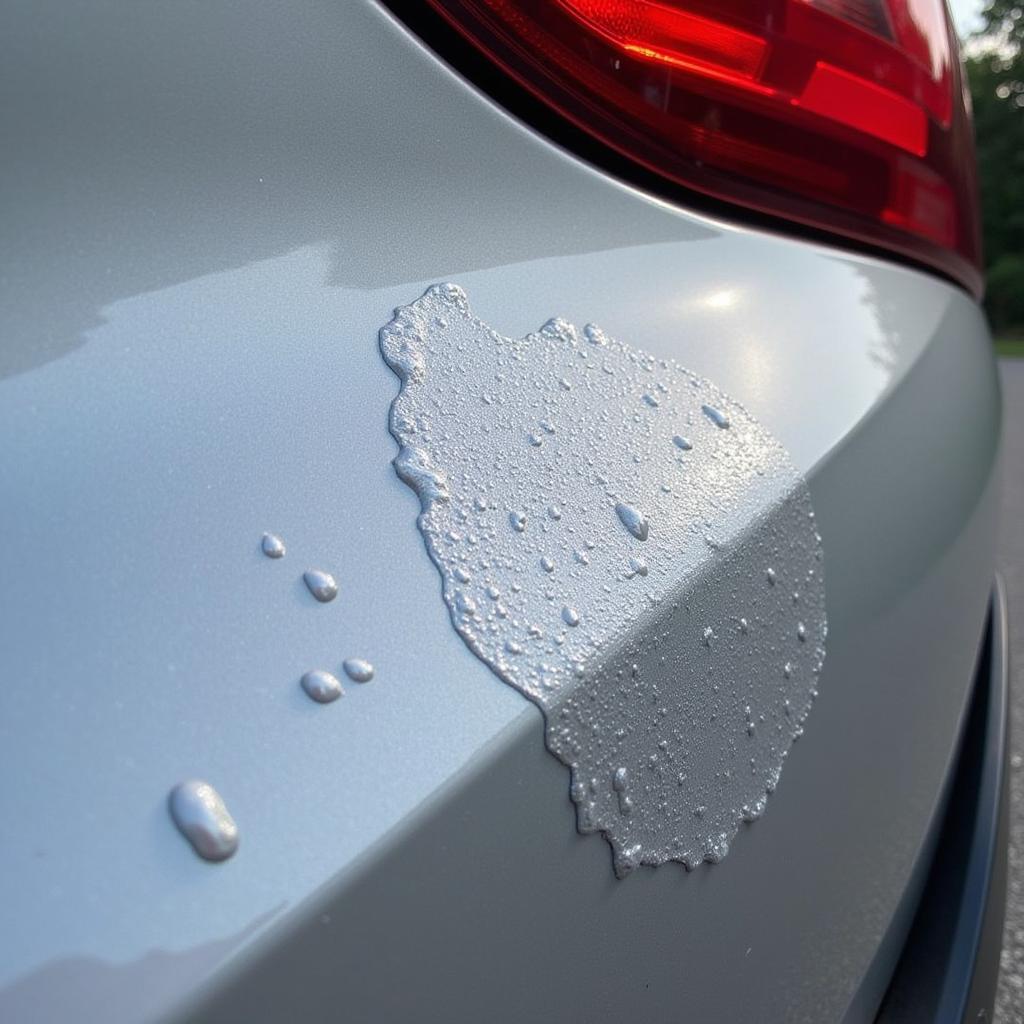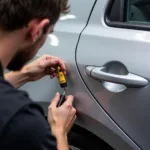Micro-blistering, those tiny, frustrating bubbles under your car’s paint, can be a real eyesore. If you’re dealing with this issue, you might have stumbled upon the term “car paint micro-blistering repair razor.” This guide will delve into everything you need to know about micro-blistering, its causes, and how to effectively address it, including the use of specialized repair tools like the razor blade.
Understanding Car Paint Micro-Blistering
Micro-blistering appears as small, raised bumps under the paint surface, often resembling tiny bubbles. While seemingly minor, these blisters can compromise the overall appearance of your vehicle and, if left untreated, lead to more serious paint damage like peeling or flaking. Identifying the underlying cause is crucial for effective car paint micro-blistering repair.
Common Causes of Micro-Blistering
Several factors contribute to micro-blistering. One common culprit is moisture trapped beneath the paint layers, often due to improper surface preparation before painting. Another cause is solvent entrapment during the painting process, especially if the paint isn’t allowed to dry properly between coats. Environmental factors, such as exposure to high humidity or rapid temperature changes, can also play a role. Poor quality paint or using incompatible paint products can exacerbate the issue.
 Close-up view of car paint micro-blistering
Close-up view of car paint micro-blistering
Car Paint Micro-Blistering Repair: Step-by-Step Guide
Addressing micro-blistering requires careful preparation and the right tools, including a specialized razor blade for car paint micro-blistering repair. Here’s a step-by-step approach:
-
Clean the Affected Area: Thoroughly clean the area with automotive soap and water, followed by a dedicated paint prep solution to remove any contaminants.
-
Assess the Damage: Carefully examine the extent of the micro-blistering. For minor cases, sanding might be sufficient. More severe blistering requires using a razor blade.
-
Using the Car Paint Micro-Blistering Repair Razor: A specialized single-edge razor blade is used to carefully pierce and flatten the blisters. This requires a delicate touch to avoid scratching the surrounding paint.
-
Sanding and Feathering: Use fine-grit sandpaper (e.g., 2000-grit) to smooth the area and feather the edges, blending the repaired section seamlessly with the surrounding paint.
-
Priming (if necessary): If the razor blade has exposed the bare metal, apply a thin coat of automotive primer to prevent rust and ensure proper paint adhesion.
-
Repainting: Apply thin, even coats of matching automotive paint, allowing each coat to dry completely before applying the next.
-
Clear Coat Application: Finish with a few coats of clear coat for protection and shine.
Why Use a Razor Blade?
Why is a car paint micro-blistering repair razor so important? It allows for precise removal of the blistered paint without excessive sanding, which can thin the overall paint layer. This precision minimizes the risk of further damage and ensures a smoother, more professional-looking repair.
“Using a specialized razor blade allows for a more controlled and precise removal of the blistered paint,” says John Smith, Automotive Paint Specialist at Acme Auto Body. “This minimizes the need for excessive sanding, preserving the integrity of the surrounding paintwork.”
Preventing Micro-Blistering
Prevention is always better than cure. Ensure proper surface preparation before painting, use high-quality paint products, and follow the manufacturer’s instructions carefully. Maintaining a clean and dry environment during the painting process is also essential.
Conclusion
Car paint micro-blistering repair, using a razor blade for precision, is a crucial step in restoring your vehicle’s appearance. Understanding the causes and taking preventative measures can help you avoid this issue altogether. By following the steps outlined in this guide, you can effectively address micro-blistering and maintain a flawless paint finish for years to come. Remember, car paint micro-blistering repair razor is a valuable tool for achieving professional-level results.
FAQ
- What is car paint micro-blistering? Micro-blistering is the formation of small bubbles under the paint surface.
- What causes micro-blistering? Common causes include moisture, solvent entrapment, and environmental factors.
- Can I repair micro-blistering myself? Yes, with the right tools and techniques, you can repair minor micro-blistering.
- What is a car paint micro-blistering repair razor? It’s a specialized razor blade used for precise removal of blistered paint.
- How can I prevent micro-blistering? Proper surface preparation, quality paint, and a controlled painting environment are key.
- Is professional help necessary for severe micro-blistering? For extensive damage, consulting a professional is recommended.
- What other tools are needed for micro-blistering repair? Sandpaper, primer, paint, clear coat, and cleaning solutions are typically required.
Need help with your car repair? Contact us via WhatsApp: +1(641)206-8880, Email: [email protected]. We have a 24/7 customer support team.

